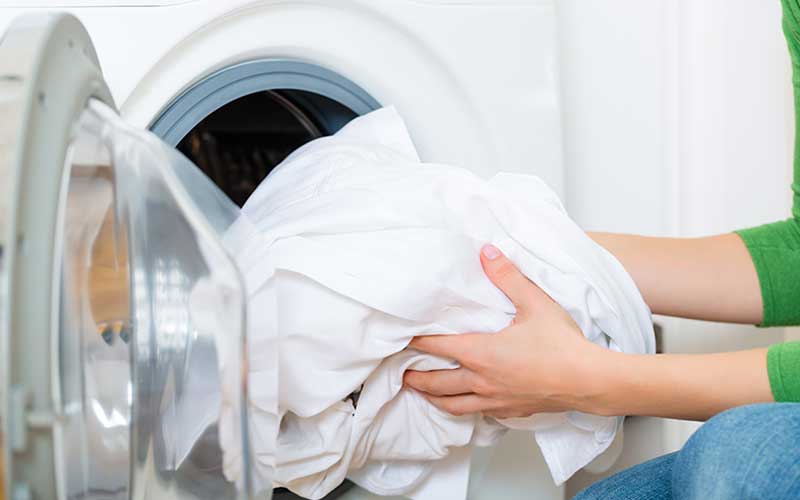A mattress protector is a thin casing that typically goes over your mattress like a fitted sheet. Most options are waterproof and protect your bed from stains, dust mites, bed bugs, and more unwanted guests. However, a mattress cover collects lots of bacteria and sweat over time, which is why you need to clean it every so often, so it works effectively and is hygienic.
That’s why in today’s article, we will discuss how to wash a mattress protector that is machine washable and one that isn’t, as well as how often should you get it cleaned.

How often should you wash a mattress protector?
Some will say you should wash your mattress protector every time you wash your bed linen, but that will imply that you’ll need another one. However, not everyone wants to spend extra money, which is why we recommend you wash yours every one to two months. That will be enough to keep your mattress fresh, clean and free of dust mites.
The reason for this difference is that your sheets come into direct contact with your body and any bacteria or dirt that might also be present. Yes, our bed linen may prevent some, but not all, of these unhygienic substances from reaching the mattress protector, meaning it can still accumulate germs and debris over time. Thus, cleaning it once every month or so will increase its effectiveness and extend its lifespan.
How to wash a mattress protector?
Your mattress pad is the silent guardian of your sleep health. It’s similar to a fitted sheet in the way that it goes over your bed and provides a fabric force field against enemies of hygienic slumber, which is why you need it.
Their job is to guard your mattress against stains, accidental spills, bacteria, and even allergens while preventing irritants like dust mites, mould, and dust.
Washing your mattress cover can help keep you and your mattress safe. But you need to know how to do so. Every product on the market is different. Some can be machine washed, while others can’t. Third, are tumble drier-friendly, and some are not. Here is what to do in any specific situation:

How to wash a non-machine washable mattress protector?
Just like every person has their unique sleep needs and preferences, every model of mattress protector has its own washing needs. That’s why you must always check the label attached to the product and follow the recommended washing instructions.
Some options are machine washable, but some aren’t, and that’s often in order to prevent shrinkage. After all, premium mattress protectors require delicate care for both durability and longevity. Here are some quick and easy instructions on how to clean a non-machine washable item:
- Step 1: Unzip and/or remove it from the mattress itself
- Step 2: Gently dab and spot clean the dirty area with a mild detergent
- Step 3: If there is one, carefully hand-wash the top part of the cover
- Step 4: To avoid shrinkage that may incur with heat, air dry
- Step 5: Wait until it’s fully dry before putting it back on your bed

How to care for a machine washable mattress protector?
If you have read the product’s label of your mattress protector and you know it can be put in a washing machine, then you can follow the instructions below:
Step 1: Check the product’s label
When it comes to cleaning a machine washable product, be sure to look at the details on the care instruction label. Doing so will give you information such as the temperature of water you should (or shouldn’t) use, if there are any special washing practices, the recommended drier cycle and more.
Step 2: Wash it
You can put your dirty mattress protector into the washing machine independently or with similar materials like sheets and pillowcases. However, we understand that you might have some follow up questions like the following:
- What is the right water temperature? – generally speaking, cold water is preferred as it will prevent any fibres from shrinking. Do you remember that beloved sweater that fit perfectly, which shrunk to a child’s size piece of clothing? That’s a lesson that you don’t want to forget when it comes to washing a delicate piece of bedding material.
- What kind of laundry detergent should you use? – your best bet is to go with a mild detergent that doesn’t have any built-in softeners. If you are wondering why that’s because the set softeners can affect your mattress’s ability to absorb all the not-so-great stuff you want to keep off of it.
- What wash cycle works best? – usually, it’s best to treat your bedding items with care. That means setting your washing machine to a “delicate” or “gentle” cycle in order to ensure your mattress encasement is thoroughly cleaned without being put through the literal wringer.
Also, you want to avoid dried-out detergent in your bedding pieces, so make sure you add another rinse cycle to your washing machine to ensure it is out. That’s because it can irritate your skin, even through your sheets and might lead to mould and mildew.
Step 3: Dry it
Once your mattress protector is as fresh as a cucumber, it’s time to get it all nice and dry before it goes back on protection duty. This step is crucial because if there’s too much leftover moisture in the material, your mattress might send an invitation to bacteria and mould, which is something you should always try to avoid.
There are multiple ways in which you can dry your mattress protector safely, and they are the following:
- Dryer on tumble dry – as we mentioned in the previous step, heat can shrink and damage your protective encasement. To avoid that from happening, you should stick to low heat settings on your dryer. And if you leave it in for a bit longer to ensure maximum dryness, the better.
- Air-dry under the sun – if you are in a place with a backyard where you can dry your clothes in the sun, you can let your protector bask in the sunshine and soak up all those wonderful fresh-air smells as well.
- Dry with a fan – if your purchase isn’t tumble drier friendly and you don’t have a sunny backyard, you can let your cover dry in front of a big fan. If that’s the route you are choosing, first make sure you’ve cleaned the fan blades, as dust can accumulate quickly on a fan, and spin right on your fresh and clean bedding.
Bottom line
Let’s be honest, mattresses are a hefty investment, so by regularly washing your quality mattress protector, you defend your bed against debris and stains that can void your warranty and ruin your bed.
Overall, the general rule of thumb for washing your protector is once every one to two months. However, certain scenarios may occur, such as being ill, having guests, or spilling food which might slightly alter this timeline.
We hope we were able to answer the how and why when it comes down to ‘How to wash a mattress protector?’ and now it’s our turn to hear from you if any questions regarding the subject were left unanswered. If you want to share some information, we would gladly hear about it in the comments below.

